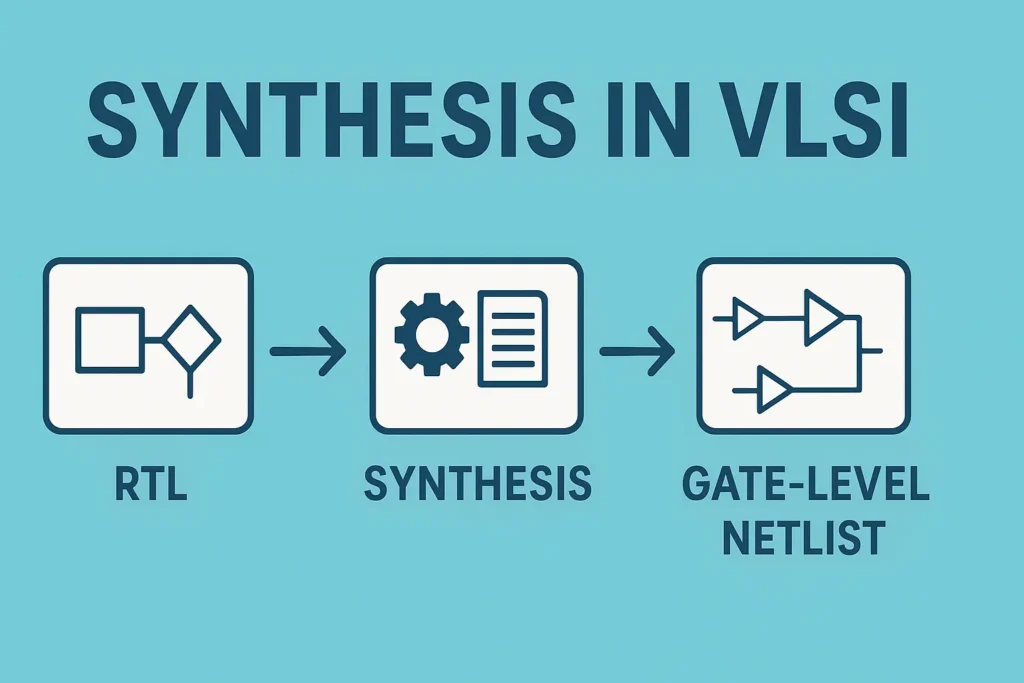What is Synthesis in VLSI | Complete Guide for Beginners
Table of Contents
- What is Synthesis in VLSI
- Understanding the Basics of Synthesis in VLSI
- Importance of Synthesis Flow in VLSI
- What is Synthesis in VLSI and Why it Matters
- Logic Synthesis in VLSI
- Role of Synthesis in the VLSI Design Flow
- Challenges in Synthesis Flow in VLSI
- Applications of Synthesis in VLSI Design
- Why Students Must Learn Synthesis in VLSI
- Conclusion
What is Synthesis in VLSI
When learning VLSI design, one of the most important steps is what is synthesis in VLSI. In simple words, synthesis is the process of converting high-level code into gate-level design. It forms the backbone of the design flow for every chip designer. Without synthesis, physical design and logic implementation cannot move forward.
Understanding the Basics of Synthesis in VLSI
In VLSI design, synthesis is the process where the register transfer level (RTL) description, usually written in HDL like Verilog or VHDL, is transformed into a netlist. This netlist represents the logic gates, flip flops, and connections that can be mapped to the targeted technology.
It bridges the gap between abstract coding and the hardware-level circuits that are used in the physical design stage.
Importance of Synthesis Flow in VLSI
The synthesis flow in VLSI is a structured set of steps that ensures RTL is correctly transformed into logic gates. It includes:
- Reading HDL Input – RTL code written in Verilog/VHDL.
- Elaboration – Expanding design hierarchy.
- Constraint Application – Timing, area, and power requirements.
- Logic Synthesis in VLSI – Converting RTL into gate-level netlist.
- Optimization – Reducing area, improving timing, lowering power.
Technology Mapping – Mapping design to targeted technology libraries.
What is Synthesis in VLSI and Why it Matters
When someone asks what is synthesis in VLSI, the answer is clear—it is the stage that makes hardware implementation possible. Without synthesis, RTL descriptions would remain as abstract code.
For chip designers, synthesis ensures the design meets constraints before it moves into physical design. This process saves time, reduces costly errors, and makes the chip more efficient.

What is Synthesis in VLSI and Why it Matters
When someone asks what is synthesis in VLSI, the answer is clear—it is the stage that makes hardware implementation possible. Without synthesis, RTL descriptions would remain as abstract code.For chip designers, synthesis ensures the design meets constraints before it moves into physical design. This process saves time, reduces costly errors, and makes the chip more efficient.
Logic Synthesis in VLSI
Logic synthesis in VLSI is the core part of synthesis. It automatically converts RTL code into a gate-level netlist. This involves selecting logic gates, creating flip flops, and connecting them to ensure the design behaves exactly as coded.
Modern EDA tools like Synopsys Design Compiler and Cadence Genus are widely used for this. These tools optimize the design for performance, area, and power consumption.
Role of Synthesis in the VLSI Design Flow
- RTL Coding → Written by engineers.
- Synthesis → Converts RTL into gates.
- Physical Design → Layout creation with floorplanning, placement, and routing.
- Fabrication → Actual chip manufacturing.
Thus, synthesis ensures that the process of converting abstract code into real hardware is seamless.
Challenges in Synthesis Flow in VLSI
While synthesis is powerful, engineers face several challenges:
- Meeting timing constraints in advanced nodes.
- Handling power optimization for portable devices.
- Mapping RTL correctly to targeted technology libraries.
- Debugging functional mismatches between RTL and netlist.
These challenges make synthesis one of the most critical skills in any VLSI course.
Applications of Synthesis in VLSI Design
- Microprocessors – Efficient synthesis ensures high-speed processors.
- IoT Devices – Low power constraints managed during synthesis.
- Automotive Chips – Reliability ensured by synthesis optimizations.
- Consumer Electronics – Fast turnaround with EDA tools.
For every project, synthesis helps chip designers meet cost, time, and performance targets.
Why Students Must Learn Synthesis in VLSI
If you are pursuing a VLSI course, understanding synthesis is a must. It is one of the first practical steps in digital IC design. By learning synthesis:
- You gain hands-on knowledge of RTL to netlist conversion.
- You understand timing, power, and area trade-offs.
- You prepare yourself for careers in VLSI design and physical design.
Conclusion
Now you clearly know what is synthesis in VLSI—it is the process of converting high-level RTL into gate-level netlists. It is the bridge between coding and hardware, making it the backbone of the VLSI design flow.By mastering synthesis in VLSI, including understanding of logic synthesis in VLSI, you can contribute to real-world chip design and prepare for a rewarding career in the



